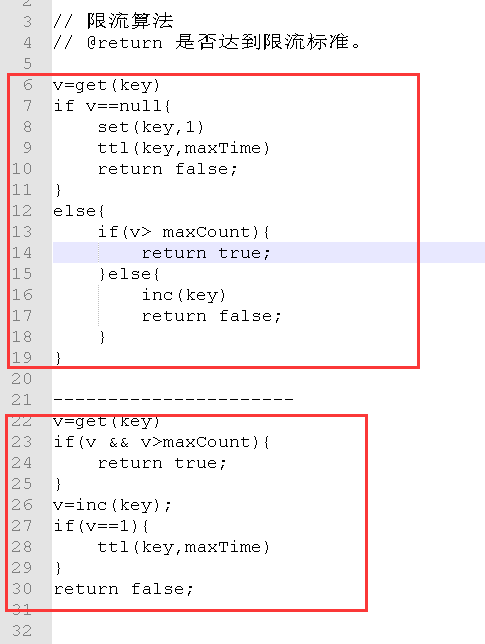当我们灵活的人工系统调用优付渠道接口进行用户签约或资金分配时,优付系统会添加API接口请求的当前限流策略。
限制每个商家的每种类型的接口请求做限流。例如:同一商家每秒仅允许20个签约请求。当每秒有20个以上的请求时,它将提示“对接口进行签名的客户端请求数超过了限制”。
然后,作为下游系统,我们需要控制并发以防止无效请求。最常用的并发电流限制方案是使用redis / jedis。为了确保原子性,在这里,我使用Redis + LUA脚本进行控制。然后,对于服务提供商,当请求数量超过设置的限流阈值时,将直接返回错误代码/错误提示,并终止请求的处理。对于调用者,我们要做的是:当并发请求超过限制的阈值时,请延迟请求,而不是直接丢弃它。
话不多说,上代码吧。
如下RedisLimiter类,服务提供方使用limit方法实现限流,服务调用方使用limitWait方法实现限流等待(如需)。
package jstudy.redislimit;
import lombok.extern.slf4j.Slf4j;
import org.springframework.beans.factory.annota
tion.Autowired;
import org.springframework.data.redis.core.RedisTemplate;
import org.springframework.data.redis.core.script.DefaultRedisScript;
import org.springframework.data.redis.core.script.RedisScript;
import org.springframework.stereotype.Component;
import java.util.Collections;
import java.util.List;
import java.util.concurrent.TimeUnit;
/**
* Redis+Lua实现高并发限流
*/
@Slf4j
@Component
public class RedisLimiter {
@Autowired
private RedisTemplate<String, Object> redisTemplate;
/**
* 达到限流时,则等待,直到新的间隔。
*
*
@param key
* @param limitCount
* @param limitSecond
*/
public void limitWait(String key, int limitCount, int limitSecond) {
boolean ok;//放行标志
do {
ok = limit(key, limitCount, limitSecond);
log.info("放行标志={}", ok);
if (!ok) {
Long ttl = redisTemplate.getExpire(key, TimeUnit.MILLISECONDS);
if (null != ttl && ttl > 0) {
try {
Thread.sleep(ttl);
log.info("sleeped:{}", ttl);
} catch (InterruptedException e) {
e.printStackTrace();
}
}
}
} while (!ok);
}
/**
* 限流方法 true-放行;false-限流
*
* @param key
* @param limitCount
* @param limitSecond
* @return
*/
public boolean limit(String key, int limitCount, int limitSecond) {
List<String> keys = Collections.singletonList(key);
String luaScript = buildLuaScript();
RedisScript<Number> redisScript = new DefaultRedisScript<>(luaScript, Number.class);
Number count = redisTemplate.execute(redisScript, keys, limitCount, limitSecond);
log.info("Access try count is {} for key = {}", count, key);
if (count != null && count.intValue() <= limitCount) {
return true;//放行
} else {
return false;//限流
// throw new RuntimeException("You have been dragged into the blacklist");
}
}
/**
* 编写 redis Lua 限流脚本
*/
public String buildLuaScript() {
StringBuilder lua = new StringBuilder();
lua.append("local c");
lua.append("
c = redis.call('get',KEYS[1])");
// 调用不超过最大值,则直接返回
lua.append("
if c and tonumber(c) > tonumber(ARGV[1]) then");
lua.append("
return c;");
lua.append("
end");
// 执行计算器自加
lua.append("
c = redis.call('incr',KEYS[1])");
lua.append("
if tonumber(c) == 1 then");
// 从第一次调用开始限流,设置对应键值的过期
lua.append("
redis.call('expire',KEYS[1],ARGV[2])");
lua.append("
end");
lua.append("
return c;");
return lua.toString();
}
}
springboot自动注入的RedisTemplate是RedisTemplate<Object,Object>泛型, 上面class使用RedisTemplate<String, Object>,bean定义如下:
package jstudy.redislimit;
import com.fasterxml.jackson.annotation.JsonAutoDetect.Visibility;
import com.fasterxml.jackson.annotation.PropertyAccessor;
import com.fasterxml.jackson.databind.ObjectMapper;
import com.fasterxml.jackson.databind.ObjectMapper.DefaultTyping;
import org.springframework.cache.annotation.CachingConfigurerSupport;
import org.springframework.cache.annotation.EnableCaching;
import org.springframework.context.annotation.Bean;
import org.springframework.context.annotation.Configuration;
import org.springframework.data.redis.connection.lettuce.LettuceConnectionFactory;
import org.springframework.data.redis.core.RedisTemplate;
import org.springframework.data.redis.serializer.Jackson2JsonRedisSerializer;
import org.springframework.data.redis.serializer.RedisSerializer;
import org.springframework.data.redis.serializer.StringRedisSerializer;
@Configuration
@EnableCaching // 开启缓存支持
public class RedisConfig extends CachingConfigurerSupport {
/**
* RedisTemplate配置
*
* @param lettuceConnectionFactory
* @return
*/
@Bean
public RedisTemplate<String, Object> redisTemplate(LettuceConnectionFactory lettuceConnectionFactory) {
// 设置序列化
Jackson2JsonRedisSerializer<Object> jackson2JsonRedisSerializer = new Jackson2JsonRedisSerializer<Object>(Object.class);
ObjectMapper om = new ObjectMapper();
om.setVisibility(PropertyAccessor.ALL, Visibility.ANY);
om.enableDefaultTyping(DefaultTyping.NON_FINAL);
jackson2JsonRedisSerializer.setObjectMapper(om);
// 配置redisTemplate
RedisTemplate<String, Object> redisTemplate = new RedisTemplate<String, Object>();
redisTemplate.setConnectionFactory(lettuceConnectionFactory);
RedisSerializer<?> stringSerializer = new StringRedisSerializer();
redisTemplate.setKeySerializer(stringSerializer);// key序列化
redisTemplate.setValueSerializer(jackson2JsonRedisSerializer);// value序列化
redisTemplate.setHashKeySerializer(stringSerializer);// Hash key序列化
redisTemplate.setHashValueSerializer(jackson2JsonRedisSerializer);// Hash value序列化
redisTemplate.afterPropertiesSet();
return redisTemplate;
}
}
并发测试通过,如下是testcase:
package jstudy.redislimit;
import lombok.extern.slf4j.Slf4j;
import org.junit.Test;
import org.junit.runner.RunWith;
import org.springframework.beans.factory.annotation.Autowired;
import org.springframework.boot.test.context.SpringBootTest;
import org.springframework.test.context.junit4.SpringRunner;
import java.util.concurrent.ExecutorService;
import java.util.concurrent.Executors;
import java.util.concurrent.TimeUnit;
@Slf4j
@SpringBootTest
@RunWith(SpringRunner.class)
public class RedisLimiterTest {
@Autowired
private RedisLimiter redisLimiter;
@Test
public void testLimitWait() throws InterruptedException {
ExecutorService pool = Executors.newCachedThreadPool();
log.info("--------{}", redisTemplate.opsForValue().get("abc"));
for (int j = 1; j <= 5; j++) {
int i=j;
pool.execute(() -> {
Thread.currentThread().setName( Thread.currentThread().getName().replace("-","_"));
redisLimiter.limitWait("abc", 3, 1);
log.info(i + ":" + true + " ttl:" + redisTemplate.getExpire("abc", TimeUnit.MILLISECONDS));
try {
// 线程等待,模拟执行业务逻辑
Thread.sleep(new Random().nextInt(100));
} catch (InterruptedException e) {
e.printStackTrace();
}
});
}
pool.shutdown();
pool.awaitTermination(2,TimeUnit.SECONDS);
}
}
【附1】
jedis限流算法。不管是redis还是jedis,其实都是利用了消息的ttl(Time to Live),即,当消息达到ttl设定的值时,消息会自动过期。ttl还见诸于mq的死信队列,队列里的消息会延迟消费,当等待ttl指定的时间后,才会自动转移到
如下jedis算法与上面lua脚本相比,实现算法殊途同归。不过,因为不具备原子性,高并发可能会出现冒的情况。所以,要实现精确限流,还是借助上面的lua。

public class JedisLimiter {
private static JedisPool jedisPool = SpringContextUtils.getBean(JedisPool.class);
/**
* 限制访问频率
*
* @param key
* @param seconds
* @param number
* @return
*/
public static boolean limit(String key, int seconds, int number) {
Jedis jedis = null;
try {
jedis = getResource();
String value = jedis.get(key);
if (value == null) {
jedis.set(key, "1");
jedis.expire(key, seconds);
return false;
} else {
Long ttl = jedis.ttl(key);
if (ttl.longValue() > 0) {
int parseInt = Integer.parseInt(value);
if (parseInt > number) {
return true;
}
jedis.incr(key);
}
}
return false;
} catch (Exception e) {
log.warn("checkReqNumber {}", e);
} finally {
returnResource(jedis);
}
return false;
}
}
【附2】
redis是使用RedisTemplate.expire来设置ttl;使用RedisTemplate.getExpire(key)或RedisTemplate.getExpire(key,TimeUnit)方法。当然,对于并发限流,我们需要后者来指定时间单位为TimeUnit.MILLISECONDS来得到精确的剩余毫秒数。
jedis是使用Jedis.expire来设置ttl;使用Jedis.ttl(key)方法,返回的时间是毫秒。
getExpire/ttl返回值:
-2:key不存在
-1:未设置ttl
n:实际的剩余ttl
【附3】
关于redis的increment :
当key不存在时,创建key,默认值是delta(不设置delta的话,则为1)。
当key存在时,按delta来递增。
【附2】
redis是使用RedisTemplate.expire来设置ttl;使用RedisTemplate.getExpire(key)或RedisTemplate.getExpire(key,TimeUnit)方法。当然,对于并发限流,我们需要后者来指定时间单位为TimeUnit.MILLISECONDS来得到精确的剩余毫秒数。
jedis是使用Jedis.expire来设置ttl;使用Jedis.ttl(key)方法,返回的时间是毫秒。
getExpire/ttl返回值:
-2:key不存在
-1:未设置ttl
n:实际的剩余ttl
【附3】
关于redis的increment :
当key不存在时,创建key,默认值是delta(不设置delta的话,则为1)。
当key存在时,按delta来递增。



